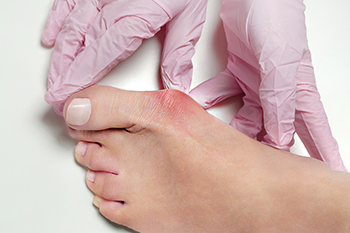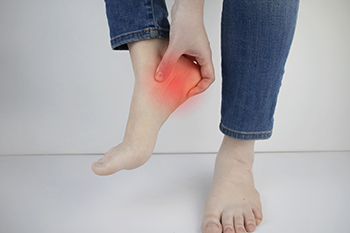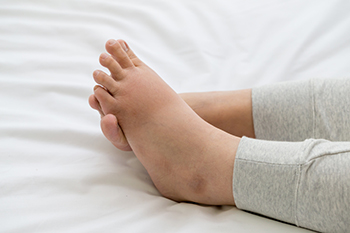Items filtered by date: September 2023
Are Bunions Affecting Your Everyday Life?
Causes of Bunions May Be More Than Just Footwear

Bunions, those bony bumps that form at the base of the big toe, are a common foot ailment that can cause pain and discomfort. While many people associate bunions with wearing tight or ill-fitting shoes, the causes are often more complex than simply blaming your footwear choices. One of the primary contributors to bunions is genetics. If bunions run in your family, you may be genetically predisposed to developing them. In such cases, the way your foot bones are structured can make you more susceptible. Another significant factor is having improper foot biomechanics. If your feet roll inward excessively when you walk, termed overpronation, or if you have a flat foot arch, the increased stress on the joint at the base of the big toe can lead to bunion formation over time. While wearing tight shoes with a narrow toe box can exacerbate the problem, they generally are not the sole cause of bunions. If you have developed a bunion, it is strongly suggested that you speak with a podiatrist who can determine the cause and guide you toward the treatment method that is best for you.
If you are suffering from bunions, contact James Pak, DPM of California. Our doctor can provide the care you need to keep you pain-free and on your feet.
What Is a Bunion?
A bunion is formed of swollen tissue or an enlargement of boney growth, usually located at the base joint of the toe that connects to the foot. The swelling occurs due to the bones in the big toe shifting inward, which impacts the other toes of the foot. This causes the area around the base of the big toe to become inflamed and painful.
Why Do Bunions Form?
Genetics – Susceptibility to bunions are often hereditary
Stress on the feet – Poorly fitted and uncomfortable footwear that places stress on feet, such as heels, can worsen existing bunions
How Are Bunions Diagnosed?
Doctors often perform two tests – blood tests and x-rays – when trying to diagnose bunions, especially in the early stages of development. Blood tests help determine if the foot pain is being caused by something else, such as arthritis, while x-rays provide a clear picture of your bone structure to your doctor.
How Are Bunions Treated?
- Refrain from wearing heels or similar shoes that cause discomfort
- Select wider shoes that can provide more comfort and reduce pain
- Anti-inflammatory and pain management drugs
- Orthotics or foot inserts
- Surgery
If you have any questions, please feel free to contact our office located in Anaheim, CA . We offer the newest diagnostic and treatment technologies for all your foot care needs.
Reducing Plantar Fasciitis Foot Pain

Plantar fasciitis is a common and painful condition that affects the heel and bottom of the foot. It occurs when the plantar fascia, a thick band of tissue that supports the arch of the foot, becomes inflamed or damaged. The pain from plantar fasciitis can be excruciating and debilitating, making simple tasks like walking a challenge. However, there are ways to reduce this pain and improve your quality of life. Included are stretching exercises for the calf muscles and Achilles tendon, custom or over-the-counter orthotic inserts to improve arch support and provide ample cushioning, and avoiding high heels and flip-flops. Other methods to decrease pain from plantar fasciitis are taking anti-inflammatory medications and using night splints to keep the foot in a dorsiflexed position, which helps stretch the plantar fascia during sleep. More advanced measures include corticosteroid injections to reduce inflammation and shockwave therapy, which stimulates healing in the plantar fascia. In rare cases, surgical intervention may be considered. If you are suffering from plantar fasciitis pain, it is suggested that you make an appointment with a podiatrist for treatment options that are right for you.
Plantar fasciitis can be very painful and inconvenient. If you are experiencing heel pain or symptoms of plantar fasciitis, contact James Pak, DPM from California. Our doctor can provide the care you need to keep you pain-free and on your feet.
What Is Plantar Fasciitis?
Plantar fasciitis is the inflammation of the thick band of tissue that runs along the bottom of your foot, known as the plantar fascia, and causes mild to severe heel pain.
What Causes Plantar Fasciitis?
- Excessive running
- Non-supportive shoes
- Overpronation
- Repeated stretching and tearing of the plantar fascia
How Can It Be Treated?
- Conservative measures – anti-inflammatories, ice packs, stretching exercises, physical therapy, orthotic devices
- Shockwave therapy – sound waves are sent to the affected area to facilitate healing and are usually used for chronic cases of plantar fasciitis
- Surgery – usually only used as a last resort when all else fails. The plantar fascia can be surgically detached from the heel
While very treatable, plantar fasciitis is definitely not something that should be ignored. Especially in severe cases, speaking to your doctor right away is highly recommended to avoid complications and severe heel pain. Your podiatrist can work with you to provide the appropriate treatment options tailored to your condition.
If you have any questions please feel free to contact our office located in Anaheim, CA . We offer the newest diagnostic and treatment technologies for all your foot and ankle needs.
Foot Swelling During Pregnancy

Edema, the swelling or puffiness of body parts, can be a common discomfort during pregnancy. It typically affects the feet, ankles, and legs. This condition can also result in discomfort, potentially limiting the range of motion in your ankles. Edema occurs when excess fluid accumulates in the body's tissues. Several factors can contribute to this buildup, including gravity, diet, medication, and certain medical conditions. Fluid is naturally pulled down into your legs and feet, and sitting or standing for prolonged periods, especially in hot weather, can make swelling worse. Excessive amounts of salt can lead to fluid retention. Edema is not contagious, nor does it have a genetic predisposition. Regular exercise, such as walking, can aid in reducing edema by working the calf muscles, which assist in fluid circulation. It is also a good idea to elevate your legs as often as possible and wear some type of compression socks. Edema during pregnancy is a common occurrence, but it can be managed with lifestyle modifications and medical intervention. For more information on edema in the feet and ankles, it is suggested that you make an appointment with a podiatrist.
Pregnant women with swollen feet can be treated with a variety of different methods that are readily available. For more information about other cures for swollen feet during pregnancy, consult with James Pak, DPM from California. Our doctor will attend to all of your foot and ankle needs.
What Foot Problems Can Arise During Pregnancy?
One problem that can occur is overpronation, which occurs when the arch of the foot flattens and tends to roll inward. This can cause pain and discomfort in your heels while you’re walking or even just standing up, trying to support your baby.
Another problem is edema, or swelling in the extremities. This often affects the feet during pregnancy but tends to occur in the later stages.
How Can I Keep My Feet Healthy During Pregnancy?
- Wearing orthotics can provide extra support for the feet and help distribute weight evenly
- Minimize the amount of time spent walking barefoot
- Wear shoes with good arch support
- Wear shoes that allow for good circulation to the feet
- Elevate feet if you experience swelling
- Massage your feet
- Get regular, light exercise, such as walking, to promote blood circulation to the feet
If you have any questions please feel free to contact our office located in Anaheim, CA . We offer the newest diagnostic and treatment technologies for all your foot and ankle needs.
Symptoms of Charcot-Marie-Tooth Disease

Charcot-Marie-Tooth disease is a cluster of inherited genetic disorders that impact the peripheral nervous system. These neuropathies disrupt the intricate network responsible for movement and sensation within the extremities, including the feet. The peripheral nervous system serves as a communication bridge between the brain, spinal cord, and muscles. Charcot-Marie-Tooth disease results in a range of symptoms that interfere with this process and dramatically influence foot health. Gradual muscle wasting in the feet and legs is a hallmark of this disease, causing increasing weakness and reduced control over time. This frequently leads to difficulties in mobility and balance. It also can result in high foot arches, known as pes cavus, and clawed toes. These structural changes can further impede proper foot function and comfort. An altered gait, often high-stepping, and a slapping sound when walking are only some of the common symptoms. Poor balance and a risk of falling are others, caused by weakened muscles and loss of sensation. Although there is no cure, it is possible to manage foot-related challenges and potentially slow down the progression of the disease. For guidance, it is suggested that you make an appointment with a podiatrist.
When dealing with systemic disease of the feet, it is extremely important to check the affected areas routinely so that any additional problems are caught quickly. If you have any concerns about your feet and ankles contact James Pak, DPM from California. Our doctor will assist you with all of your podiatric needs.
Systemic Diseases of the Feet
Systemic diseases affect the whole body, and symptoms usually are displayed in the feet. This condition can make a patient’s ability to walk unbearable. Systemic diseases include gout, diabetes mellitus, neurological disorders, and arthritis.
Gout – is caused by an excess of uric acid in the body. Common symptoms include pain, inflammation, and redness at the metatarsal/phalangeal joint of the base big toe. Gout can be treated by NSAIDs to relieve pain and inflammation, and other drugs that lower the acid levels in the body.
Diabetes mellitus – is an increase in the level of blood sugar that the body cannot counteract with its own insulin. Failure to produce enough insulin is a factor in Diabetes.
Diabetes of the Feet
Diabetic Neuropathy – may lead to damaged nerves and affect the feet through numbness and loss of sensation.
Peripheral Vascular Disease – can restrict the blood flow to the feet, and often times lead to amputation of the feet.
If you have any questions please feel free to contact our office located in Anaheim, CA . We offer the newest diagnostic and treatment technologies for all your foot and ankle needs.

